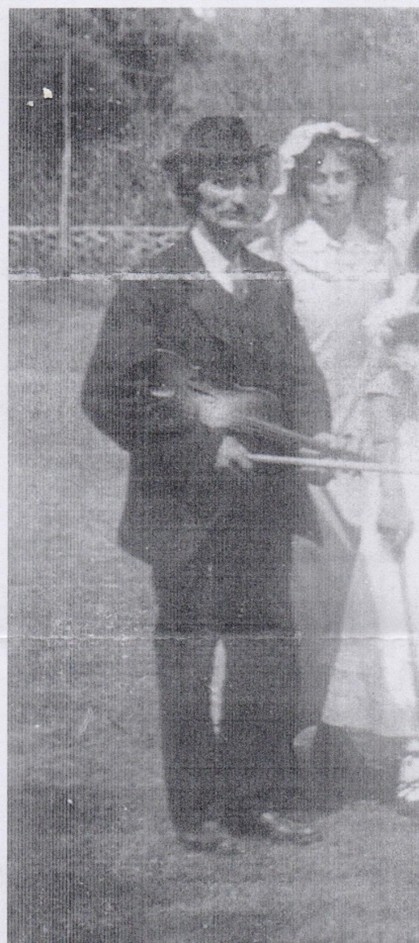Step-dancing in and around Essex in ancient times: a not-so-personal memoir
By Phil Heath-Coleman

Illustration of ‘admirable specimens of the Essex labourer’ step dancing at Purleigh Bell (from ‘The Essex Labourer’, Benham: Essex Review [n.d.])
During the great storm of 1987 – which some folk will think of as being a long time ago, but will always be just another of my yesterdays to me – the Woolpack at Chipping Hill in Witham was without power for days on end, and we regulars (I lived opposite at the time) migrated to the White Horse at the top of Church Street or even further afield. It was at the George in the High Street on one of those days that I ran into Colin Smith, – another of those regulars of far longer standing than myself and something of a local character – , and found him, to my surprise, ‘tap-dancing’ in the bar. I told him I didn’t know he could dance, to which he replied in the broad Essex accent which could still be heard locally: “I’ve been Jack the Ladding all my life …”.
That wasn’t the first time I’d heard the expression used of what I thought of as step-dancing, but it was the first time I’d heard it used in the wild (rather than as in ‘They used to call it Jack the Ladding …’ or some such): I don’t recall any of the old steppers I met in those days referring to what they did in that way, whether ‘Herbie’ at the Tower Arms in South Weald, ‘Cubby’ at the Stag on Hatfield Heath (who’d learnt to step in the RAF), or – last but not least – Johnny ‘Scuffer’ Smith, who sometimes couldn’t resist the odd step at one of the many pubs where he was a familiar face, despite his ‘dicky ticker’.
In those days they’d dance to anything, often covering much more ground than would be considered the rule nowadays. It was the Bluebell Polka which I recall being asked for, and which could long still be found on the ancient jukebox at Mashbury Fox – where it had once presumably served the same purpose.
I have always taken it for granted that ‘Jack the Ladding’ took its name from the tune known popularly as Jack’s the Lad (otherwise the College/Sailor’s Hornpipe), which was also known in Essex as Jacky Robinson, Vaughan Williams having come across a version involving a ditty referring to someone of that name, which he described as a ‘dancing song’, in the Dog at East Horndon (oddly enough Beatrice Hill referred to her version of the ubiquitous stepping tune known elsewhere as the Yarmouth or Manchester Hornpipe as Jacko Robinson). The versions which the steppers knew were simpler than the Jack’s the Lad of the Last Night at the Proms, which was once universally familiar as the Sailor’s Hornpipe, of course. This is how Billy French had sung it for Neil Lanham by the roadside somewhere near Sudbury in the 1950s:
Billy French: Jack’s the Lad
As well as a highly step-worthy version of Old Joe the Boat is going over, Billy French also diddled a stepping tune which married a simplified first strain of the Harvest Home with a second strain of Fisher’s Hornpipe which resembled William Kimber’s. Neil told me that many of the steppers in the area preferred to step to ‘tuning’ (mouth music) rather than to a musician:
Billy French: Medley [Harvest Home /Fisher’s Hornpipe]
Over at Thaxted, in 1911, the opera singer Clive Carey, who lived nearby in Hedingham, noted a number of familiar country dance tunes, including the King of the Cannibal Islands, Haste to the Wedding, Trip to the Cottage, and The Triumph from the fiddler Alf Bishop, a travelling showman (and latterly photographer) who had settled in Thaxted, from whom he also noted a couple of hornpipes, which were conceivably used for step dancing: the Fisherman’s Hornpipe (which I, at least, suspect might ultimately be a version of Fisher’s Hornpipe), and the Gypsy’s Hornpipe – possibly a reference to his source – which combines the first strain of the Flowers of Edinburgh and the second strain of the now less familiar but once popular Miss Baker’s Hornpipe (and it’s easy to see how the first few notes of the second strain of Miss Baker’s Hornpipe might be confused with those of the Flowers of Edinburgh) [for those who can’t read (music) I offer my own – partly transposed – take]:
Alf Bishop’s ‘Gypsy’s Hornpipe’ [Flowers of Edinburgh/Miss Baker’s Hornpipe]

Alf Bishop in 1905
The gipsy fiddler Moses Shaw was once also well known in and about Thaxted, and it’s possible to see resemblances between Alf Bishop’s repertoire and that of the musical Shaw family as a whole, who played a significant part in musical life in the adjacent parts of Herts, Cambs and Essex, being particularly associated with Molly Dancing, but that’s another story [though if you’re interested see Romany Routes, vol. 11, no.6, March 2014/vol.13, no. 3, June 2017]
Also at Thaxted, on the same occasion, Carey noted a few tunes from Harry Smith, including a ‘Hornpipe’, which resembles the ‘vernacular’ version of the Wonder Hornpipe (as recorded, for example, from such notables as ‘Scan’ Tester in Sussex and Dolly Curtis – and others – in Suffolk: again, and for the same reason, I offer my own take – with some re-imagination of the second strain on the lines of other field recordings.
(Harry Smith’s) ‘Hornpipe’ [Wonder Hornpipe]
To round of the recordings, we must obviously go back to the real thing in the shape of Neil Lanham’s recording of Charlie Cutmore – formerly the landlord of the Plough at Belchamp St. Paul, where a board with a cross on it had been kept for stepping – playing his father Joby’s version of the familiar Yarmouth/Manchester Hornpipe:.
Charlie Cutmore: Joby Cutmore’s stepdance [aka the Yarmouth/Manchester Hornpipe, Pigeon on the Gate]